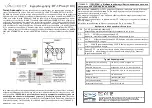
6
DEMO MANUAL DC290
NO-DESIGN SWITCHER
OPERATIO
U
Dropout Operation
When the input supply voltage decreases toward the
output voltage, the duty cycle increases toward the maxi-
mum on-time. Further reduction of the supply voltage
forces the main switch to remain on for more than one
cycle until it reaches 100% duty cycle. The output voltage
will then be determined by the input voltage minus the
voltage drop across the P-channel MOSFET and the
inductor.
Low Supply Operation
The LTC1877 and the LTC1878 can function on an input
supply voltage as low as 2.65V. The maximum allowable
output current is reduced at this low voltage because the
R
DS(ON)
of the P-channel switch increases. Therefore, the
user should calculate the power dissipation when the
LTC1877 or the LTC1878 is used at 100% duty cycle with
low V
IN
. See the LTC1877 or the LTC1878 data sheet for
additional information.
Slope Compensation and Inductor Peak Current
Slope compensation provides stability in constant fre-
quency architectures by preventing subharmonic oscilla-
tions at high duty cycles. It is accomplished by internally
adding a compensating ramp to the inductor current
signal at duty cycles in excess of 40%. As a result, the
maximum inductor peak current is reduced for duty
cycles >40%. See the inductor peak current as a function
of duty cycle graph in Figure 4.
DUTY CYCLE (%)
0
MAXIMUM INDUCTOR PEAK CURRENT (mA)
1100
1000
900
800
700
600
80
dc290A F04
20
40
60
100
LTC1877 @ V
IN
= 5V
LTC1878 @ V
IN
= 3.3V
Figure 4. Maximum Inductor Peak Current vs Duty Cycle
JP3
V
IN
SYNC/MODE
RUN
GND
GND
LTC1877/LTC1878
High Efficiency Monolithic Synchronous
Step-Down Regulator
DEMO CIRCUIT DC290A
(408) 432-1900
V
OUT
I
OUT
+
+
I
IN
+
V
IN
+
1.5V
2.5V
3.3V
0PEN
GND
E1
E2
E3
E4
E5
E6
E7
JP1
JP2
JP3
JP3
LOWER POSITION (L)
UPPER POSITION (U)
A
V
A
+
LOAD
V
V
OUT
Figure 5. Proper Measurement Setup
How To Measure Voltage Regulation
When trying to measure voltage regulation, remember
that all measurements must be taken at the point of
regulation. This point is where the LTC1877’s and
LTC1878’s control loop looks for the information to keep
the output voltage constant. In this demonstration board,
this point occurs between V
OUT
(E6) and GND (E4).
Measurements should be taken at these points and not at
the end of test leads at the load. Refer to Figure 5 for the
proper monitoring equipment configuration.
This applies to line regulation (input-to-output voltage
regulation) as well as load regulation tests. In doing the
line regulation tests, always look at the input voltage
across the input terminals, V
IN
(E2) and GND (E3) .



























